The New Italy Museum Collection Policy (2023)
The New Italy Museum Collection Policy (2023)
Guided by our Mission Statement, through the Collection Policy and museum displays, the Museums Group wishes to perpetuate the spiritual legacy of the Italian pioneers and families who journeyed from Italy and established the settlement that became ‘New Italy”. We celebrate and honour the multicultural heritage shared by all peoples and acknowledge the traditional owners.
The two core collecting areas are
1. The story of the 1880 Marquis de Rays Expedition and settlement of expeditioners in New Italy. This is told in the ‘Museum’. Items acquired will fit into 1875 to 1955 date range.
2. The Italian migration to the Northern Rivers region. This is told in the ‘Italian Pavilion’. Items acquired will fit into 1875 to 1988 date range.
Objects include machinery, tools of trade, furniture, implements, clothing, statuary, utensils, object d’art, domestic and ornament items; electronic media, records, books, papers, writings, paintings, pictures, photographs, lithographs and printed or written material: clothing, jewellery, utensils, musical instruments and personal effects; Film, audio-visual recordings and sound recordings.
Existing long term/permanent loans will be translated into donations. Short term loans are for specific purposes e.g. exhibitions.
Acquisition Criteria
The Acquisition Committee will assess all objects against the following criteria:
• Relevance to core collecting areas
– NIMI will only collect objects that assist the organisation in achieving its purpose and are related to the two core collecting areas.
• Significance
– Significance refers to the values and meanings that items and collections have for people and communities.
– Priority will be given to objects that are significant for their historic, aesthetic, research or social, spiritual value.
• Provenance
– Objects should have established provenance with documentation and/or support material.
• Condition and conservation
– Objects should be in a viable condition with manageable maintenance and conservation requirements.
• Storage
– There should be availability of appropriate storage for the object. Large items may not be collected if space is not available to accommodate them in perpetuity. In such instances, where the items are of historical or technological significance, photographic records may be taken for archival purposes.
• Legal requirements
– NIMI will only collect objects where the donor/seller has legal title
– Weapons and Shipwreck material – NIMI will seek advice to ensure that any weapons (including firearms) and shipwreck material meet current state and national legislation requirements.
• Conditions
– NIMI will not acquire objects which have conditions / restrictions on how/when they may be displayed or used imposed by donors.
The other consideration is safety. Any object that could be dangerous to volunteers and visitors should undergo a higher degree of scrutiny by the Acquisitions Committee.
DOCUMENTATION
After consultation NIMI requires potential donors to complete a Donation Form – Deed of Gift With Transfer Of Ownership which details:
• Donor’s details
• Description
• Who, where, when it was used
• Any other relevant information
• Photographs if any
Once the Donation Form and object are received details are entered into NIMI’s collection management system Musarch.
DEACCESSIONING AND DISPOSAL
Deaccessioning is the process of removing an object from the collection.
Deaccessioning Criteria
An accessioned object must meet one or more of the following deaccessioning criteria to deaccessioned:
• little or no relevance to the Collection Policy
• little or no significance
• lack of provenance or documentation which establishes relevance to the collection
• badly damaged or in poor condition
• there is a better quality duplicate in the collection
• inability to safely store, manage or conserve the object
• care costs are prohibitive
• acquisition of a like object of greater significance rendering earlier acquisition redundant
Deaccessioning Process
• A report outlining the reasons for de-accessioning will be prepared by the Museum Monday Group member/s.
• A majority of the Museum Monday Group members (not including the member who prepared the report) will formally endorse/not endorse deaccessioning.
• There will be a ‘cooling off period’ of 60 days before disposal.
• All decisions made will be documented and saved in both hard copy and digitally in the appropriate places. All object records (including in MUSARCH) will be updated to detail that the object has been deaccessioned.
• If deaccessioned objects are sold, the proceeds will go toward collection care or new acquisitions for the collection.
• The accession number of deaccessioned objects will not be reused.
Disposal
Once an object has been formally deaccessioned from the collection, the following methods of disposal are in order priority:
• Return the object to the donor or donor’s closest family. Every effort to be made to find the donor. If the donor cannot be found, the object should be: o Transferred to another museum or appropriate institution with similar Objects.
o Auctioned
o Sold
o Destroyed or recycled
No NIMI committee members or volunteers may benefit from or acquire objects that have been deaccessioned unless they are the original donor or donor’s family.
ORAL HISTORIES
NIMI will acquire oral histories that relate to the Core Collection Areas.
NIMI will conduct oral histories only using best practice. Oral History Australia states that, “Best Practice involves:
• ethical conduct and informed consent in interviews and postproduction
• high quality recording
• well planned and executed oral history projects
• archiving oral history interviews for longevity and accessibility.”https://oralhistoryaustralia.org.au/guidance/practise/
Oral histories will not be acquired if:
• there is no relation to the Core Collection Areas
• the listening or viewing quality is very poor
• there is no appropriate documentation with the oral history including a signed agreement with the interviewee. Transcripts would be desirable.
• the ongoing maintenance and preservation are beyond the capacity of NIMI
ACCESS
NIMI aims to make the collection available to members, descendants, historians, researchers, and the wider community:
• Through regular opening hours of the Museum and Pavilion (objects and information in exhibitions)
• A selection of images and object information is available online via the NIMI website
• Interested parties can make an appointment to access collection objects and records under the supervision of the Museum Monday Group.
NIMI will take requests on a case-by-case basis from researchers for more in-depth access to collection objects and records. Contact can be made via email: catalogue@newitaly.org.au
Item Donation Form use this link to contact us about your item for donation.

